ASUS VG236H 23-inch 3D Display Review: 120Hz is the Future
by Brian Klug on August 7, 2010 2:48 AM ESTColor Quality
Now let’s get to the meat of the display characteristics. As usual, we report two main quality metrics: color accuracy (Delta-E) and color gamut. Color gamut refers to the range of colors the display is able to represent with respect to some color space. In this case, our reference is the AdobeRGB 1998 color space, which is larger than the sRGB color space. So our percentages are reported with respect to this number, and larger is generally better.
Color accuracy (Delta E) refers to the display’s ability to display the correct color requested by the GPU and OS. The difference between the color represented by the display, and the color requested by the GPU is our Delta-E, and lower is better here. In practice, a Delta E under 1.0 is perfect - the chromatic sensitivity of the human eye is not great enough to distinguish a difference. Moving up, a Delta E of 2.0 or less is generally considered fit for use in a professional imaging environment - it isn’t perfect, but it’s hard to gauge the difference. Finally, Delta E of 4.0 and above is considered visible with the human eye. Of course, the big consideration here is frame of reference; unless you have another monitor or some print samples (color checker card) to compare your display with, you probably won’t notice. That is, until you print or view media on another monitor. Then the difference will no doubt be apparent.
As I mentioned in our earlier reviews, we’ve updated our display test bench. We’ve deprecated the Monaco Optix XR Pro colorimeter in favor of an Xrite i1D2 since there are no longer up-to-date drivers for modern platforms.
For these tests, we calibrate the display and try to obtain the best Delta-E we can get at both 200 nits of brightness for normal use, and 100 nits for print brightness. We target 6500K and a gamma of 2.2, but sometimes the best performance lies at native temperature and another gamma, so we try to find what the absolute best performance could be. We also take an uncalibrated measurement to show performance out of the box using either the manufacturer supplied color profile, or a generic one with no LUT data. For all of these, dynamic contrast is disabled.
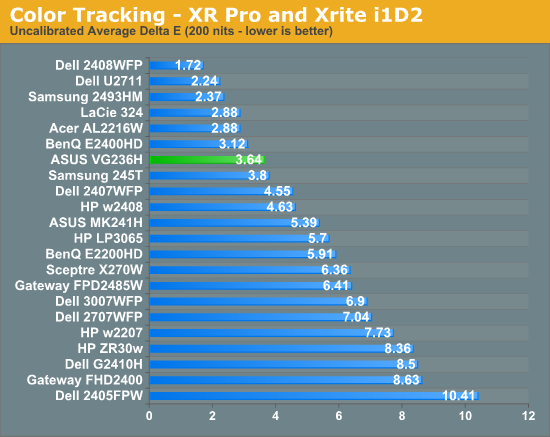
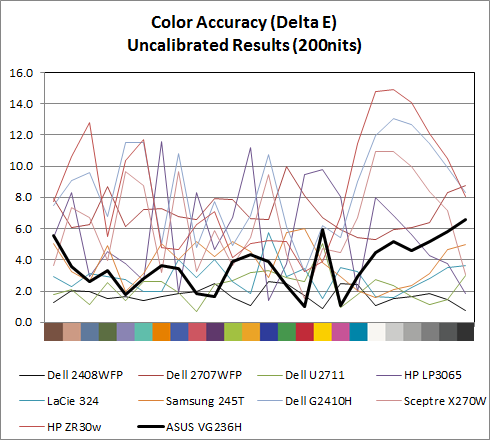
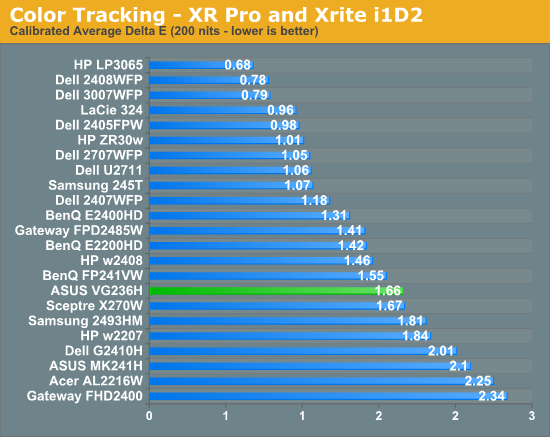
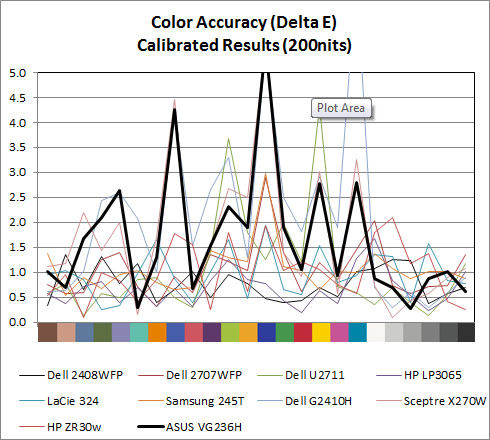
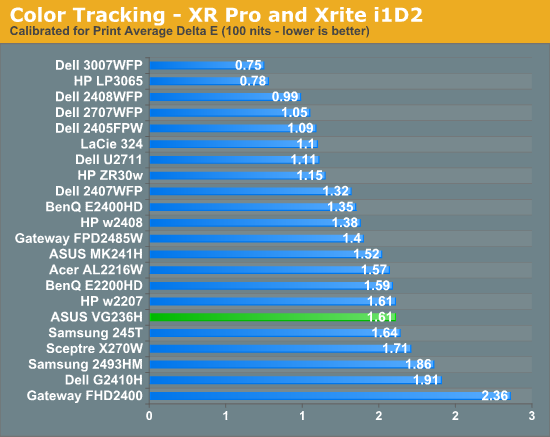
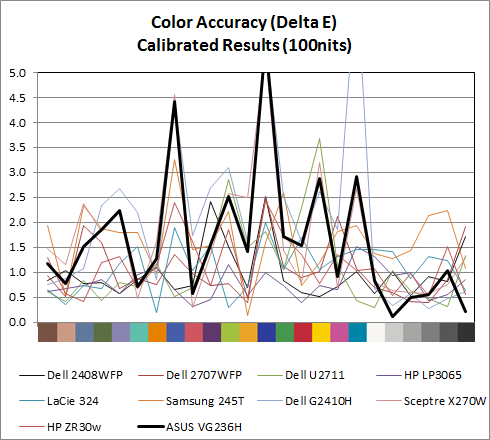
Performance uncalibrated, entirely out of the box is actually very good, at a respectable 3.64. When I first started working on the VG236H I didn’t notice any color tints or weird hues, and upon measuring the display, found the white temperature to be almost exactly 6600K, very close to our 6500K target for calibration. This is nice to see out of the box. For gamers interested in ballpark color reproduction but not professonal level absolute colormetric reproduction, this is adequate.
Moving on, at 200 nits the VG236H gets a bit more accurate, down to 1.66, but still isn’t quite as good as an IPS panel. Still, not bad for a TN. Going down to 100 nits, we get a bit better, moving down to 1.61, but still not that elusive sub 1.0 the highest quality displays can deliver. What about gamut?

As expected, gamut is right around where we’d expect it to be for the TN, sRGB display. Interestingly enough, the OSD controls do have an sRGB mode, though I don’t think it’s as necessary as it would be on say a wide gamut display. But it’s there for certain.











121 Comments
View All Comments
Gris - Monday, August 9, 2010 - link
"Manufacturers need to create circularly polarized monitors before it is really usable."I think you may be right, (if that's even viable), but more so for tv's than computer monitors where viewing in a vertical position is more the norm.
zoxo - Monday, August 9, 2010 - link
Yes indeed, but why settle for a half-solution?But I agree, that anything that uses passive glasses is a huge step-up. Those active glasses drive me nuts.
ChongDOTcom - Monday, August 9, 2010 - link
I guess this display is quite popular, since it's sold out at nearly every online retailer. The only site I could find that has some in stock was Best Buy, where I luckily just ordered one last night.I was originally going to get the Alienware Optx, but that's the same price but doesn't come with the glasses. It looks a little cooler, but they seem extremely similar. I don't even need the glasses, though (I have an ATI card). I'll likely sell them.
Anybody know any workarounds to get 3D to work on this screen? I'd be willing to purchase another 3D kit.
meldog11 - Tuesday, August 10, 2010 - link
i think most of you are missing the point...the point is true functioning 3-d gaming on almost 24 inches of landscape @ true 1080p.....i hear you throwing out a huge wish list of things that arent available now nor where they available before....but this is closer to your wish list of demands, at a price point that 3 months ago you could only get 22 inches and 1680 x 1050.....what i took from this whole review is that the reviewer was overwhelmingly impressed with the 3d technology...meaning it actually "works" and a worthy skeptic is converted!...so if your not a fan of 3d technology then fine, if you wont be impressed with a new level of immersion in the games that you play fine, if close to 24 inches of landscape dont improve on the previous 22 inches of landscape fine.....but make no mistake about it this is a definite step in the right direction in terms of gameplay and performance for an imerging tech and at a price point that is impressive or at least competative to its predeccesors......just my humble opinionRaZz! - Thursday, August 12, 2010 - link
Nice review. In the conclusion you mention the Acer and Alienware monitors - in my opinion the LG W2363D should be named in this league as well.Since reviews of these monitors are cluttered all over the web on different sites with different test methods etc, it's pretty hard to really compare the monitors respectively the results from these tests.
I'd really love to see these 120Hz monitors tested with the same test methods - compared from one source.
Anandtech would do a lot of people a favor with a 120Hz monitor roundup ;) Many forums have threads going on with exact this topic and a lot of people are unsure which monitor is better. Facts and detailed field reports are very rare, even though some of these monitors are out there for quite some time already.
On a side note: there have been a lot of issues reported for the Acer, like too aggressive Overdrive which makes fonts too sharp and hardly readable as well as green and red coronas when doing fast turns in games. Videos of these problems can be found on Youtube for example.
Sabresiberian - Thursday, August 12, 2010 - link
I'm sooo glad to read an up-to-date article that describes the 120Hz LCD monitor in a discreet state. The previous articles I read (back when they first came out ) left me with the impression that they weren't really 120 Hz, just 60Hz gimmicked-up, and not much better. Brian has answered that question and I am thrilled to know we aren't entirely hampered with 60Hz as a standard for future video.Looking forward to a real quality unit along the lines of the Dell U2711 or HP ZR30w in true 120 Hz capability. Better yet, true 240 Hz so that each eye can live with 120 Hz in a 3D setup! Heh.
Orip - Saturday, August 14, 2010 - link
Seems to be doing whatever the Asus VG236H is doing (except that the 2233RZ is 22" but is also a 16:10).What am I missing?
Orip - Saturday, August 14, 2010 - link
Being keen on the sanctity of my fps I'm still using my good ole' trusted Iiyama CRT.Now that LCDs are nailing down 120mhz I could finally grab one but there seem to be no concensus as to where one's money would be best spent.
The samsung is cheaper by far out of all the 120mhz LCDs out there (atleast in israel that's the case).
A lil' help here would be welcome :)
Thanks! :)
fingerbob69 - Tuesday, August 17, 2010 - link
As the subject line says 120hz ips panels are the way to go; colour reprodution and fluidity of movement... with no issue regarding viewing angles.I have one of those NEC ea231wmi panels and I have to say it's fantastic. I play a lot of fps games and have not noticed any colour distortion, left to right, ghosting or lag and I've had no problem with the anti glare coating. Maybe I'm just too easily pleased!
DarkUltra - Thursday, August 19, 2010 - link
I don't see any black level impressions. Just that contrast is good and MEtro 2033 needs a bump in the gamma setting in 3D mode. Other reviews have found the black level on this monitor bad:The display was equally unable to separate very dark grays from absolute black. As a result, we had a difficult time seeing what was happening in the Blu-ray version of Watchmen’s opening fight sequence.
http://www.maximumpc.com/article/reviews/asus_vg23...
This is not acceptable to me. I don't wanto mess with gamma settings in games and reduce the color representation further. I guess I'll get the LG W2363D or wait for a 16:10 or LED backlit 120hz monitor.
The other 120hz monitors have other issues, AW2310 have blurring and smearing in 2d mode despite the 120hz performance, GD245HQ have serious sharpness issues, the others are "only" 22" panels.